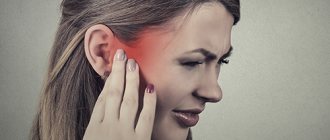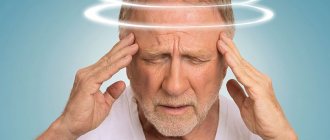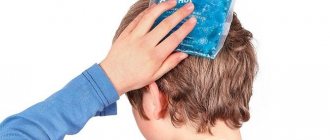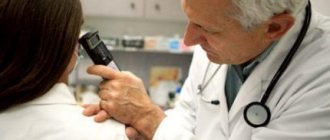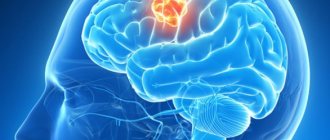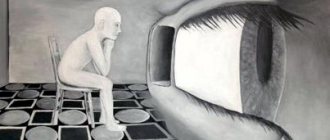Sustavin.ru » Osteochondrosis » Cervical osteochondrosis » How to treat dizziness with cervical osteochondrosis
0
1296
Article rating
Dizziness is the result of poor circulation in the brain. This symptom often occurs with inflammatory diseases of the musculoskeletal system. Dizziness with cervical osteochondrosis can appear in the morning after waking up or in the middle of the working day and last several seconds or hours.
Dizziness with cervical osteochondrosis
If a frightening symptom occurs, you should immediately contact a specialist. You can get rid of dizziness with the help of medications and exercises.
Why do you feel dizzy with osteochondrosis?
The joints of the cervical spine are most susceptible to osteochondrosis, since their size is small and they experience enormous load. The spinal column must support the head during its various turns and tilts. Even slight displacement of discs or muscle tension leads to compression of vital arteries, blood vessels, veins and nerve endings. That is why headache is a frequent guest in osteochondrosis.
Dizziness is especially severe after sleep, when a person stands in a horizontal position. Often the head with osteochondrosis hurts after sleeping on a high pillow - the unnatural curves of the cervical spine compress the arteries and blood vessels, which, therefore, cannot pass a sufficient amount of blood through themselves. If a person simultaneously suffers from atherosclerosis, the problem is aggravated, since the lumen of blood vessels with this disease is significantly narrowed.
traditional methods of combating osteochondrosis
Massage for dizziness
Light self-massage and vibration therapy massage performed with a special vibration massager will help relieve dizziness syndrome due to osteochondrosis. Massage by a chiropractor or self-massage according to the doctor’s instructions consists of kneading the muscle tissue in which lactic acid accumulates, due to the accumulation of which pain will be felt in the first sessions. In the process of kneading and rubbing, blood circulation will improve, the blood, washing the muscles, will begin to dissolve and disperse the acid. Thanks to therapeutic massage, compactions in the cervical vertebrae area will decrease and tension in the muscles will ease. Here are some massage exercises:
- Using circular movements, you need to knead the scalp above the ear and to the back of the head;
- sitting on a chair, with both hands, stretch the neck muscles behind the ears, at the base of the skull;
- it is necessary to rub the muscles between the shoulder blades and above them. This exercise will require a massager or outside help, since it is impossible to reach the shoulder blades with your hand.
Neck massage for osteochondrosis should be carried out carefully, without strong impacts. Because careless pressure, especially in the spinal area, can forcefully displace the intervertebral discs. Massage will also help restore the flow of blood and oxygen to the brain, which will stop dizziness. But massage procedures are contraindicated for patients with skin diseases.
Features of dizziness in osteochondrosis
But how can you understand that dizziness is a symptom of osteochondrosis and not another disease? Here are some signs of a headache that is caused specifically by osteochondrosis.
- Mostly the headache occurs after waking up, when a person gets out of bed.
- Along with dizziness, a person feels nausea, which can lead to vomiting.
- Due to poor oxygen supply to the vestibular apparatus, it seems to the patient that all surrounding objects are moving and spinning.
- Often the patient feels that the headache is localized in the face.
- With serious osteochondrosis, it becomes difficult for a person to move, he cannot find a foothold, and loses stability. This can cause injury if you fall.
- Dizziness may be accompanied by congestion, ringing, whistling in the ears, and hearing acuity may be reduced.
- Another additional symptom is impaired sweating. A person with a headache may become pale or, conversely, red.
- Vision also suffers; during dizziness, a white veil, colored flashes or black spots may appear before the eyes.
- Often, impaired blood circulation in the brain leads to various cardiovascular pathologies. A person may feel numbness in the hands, rapid heartbeat, and nagging pain in the chest.
- To definitively check whether dizziness is associated with osteochondrosis, sharply raise or turn your head. If the pain intensifies, there should be no doubt.
Usually the symptoms do not last long, for 5-10 minutes. If you experience such symptoms, you should consult a doctor as soon as possible. He will check your suspicions, help you reliably make a diagnosis and prescribe adequate treatment that is necessary specifically in your case.
Features of dizziness attacks
This unpleasant symptom usually manifests itself in the morning, in the first minutes after waking up. You may feel dizzy during the day, especially as a result of sudden movements of the neck. At such a moment, the patient may feel a slight crunch in the vertebral area.
At the initial stage of the disease, dizziness almost does not manifest itself, but as the disease worsens, the symptom can make itself felt daily and even several times.
When the patient feels dizzy, his vision darkens and his ears may ring. In some cases, the patient may lose consciousness, so at the first sign of this phenomenon, you should lie on your back and completely relax.
With osteochondrosis, the patient may exhibit other symptoms:
- Hearing impairment and ringing in the ears;
- Uncontrolled movements of the eyeballs in the horizontal direction;
- Decreased vision;
- Loss of coordination of movements;
- Nausea, possible vomiting;
- Irritability;
- General weakness.
Drug treatment of dizziness in osteochondrosis
If you experience dizziness and other symptoms of osteochondrosis, you need to treat the underlying disease in order to eliminate the secondary symptom. Treatment of this disease is carried out in several main areas.
- Nonsteroidal anti-inflammatory drugs will help relieve muscle swelling, get rid of acute pain, and suppress the inflammatory process. This reduces pressure on the blood arteries. Anti-inflammatory drugs include Diclofenac, Nimesil, Nise, etc. They should be taken systematically, in courses.
- Antispasmodics or painkillers will help get rid of acute pain in the cervical spine and relax the muscles. Among them are Analgin, Noshpa, Baralgin.
- Drugs to improve vascular patency. It is aimed at dilating the blood arteries so that the brain receives more blood, and with it oxygen and nutrients. Actovegin improves vascular elasticity, increases nerve patency, and protects the brain from hypoxia. Cinnarizine thins the blood, accelerates blood circulation in tissues, dilates blood vessels. Mydocalm is another effective drug that has a vasodilator property, perfectly relieves pain and improves blood microcirculation in the brain tissue.
- Vitamins are another necessary warrior in the fight against osteochondrosis. They are necessary to strengthen bone tissue, regenerate cartilage, and improve the patency of nerve tissue. Most often, B vitamins, retinol, vitamins C and E are prescribed for osteochondrosis.
- Chondroprotectors are needed to restore cartilage tissue, which flattens and compresses blood vessels. Among them are Teraflex, Artron, Movex. Some of them are taken only orally, others are intended for complex treatment - tablets and ointment.
- Warming ointments have a local anesthetic effect. Ointment applied to the neck increases blood circulation, dilates blood vessels, warms and relieves pain within 5 minutes. Among such products are Capsicam, Finalgon, Nurofen, Voltaren, etc.
Remember that self-medication is unacceptable; medications and their dosages should be prescribed only by the attending physician.
how to sleep properly with cervical osteochondrosis
Treatment
It is very important to promptly treat dizziness. To do this, you should use a number of techniques aimed at:
- Getting rid of signs of compression;
- Improving the condition of damaged discs between the vertebrae or their restoration;
- Elimination of the problem of compression of the vertebral artery and spinal canal;
- Relaxation of nerve endings.
Drug treatment
Pharmaceutical therapy is determined and prepared by the attending physician. Typically, the treatment complex includes the following:
- Muscle relaxants - to relieve excessive muscle tightness. This can be Baclofen, as well as Botox and Sirdalud injections.
- Anti-inflammatory and painkillers. Ibuprofen, Analgin, Voltaren, Movalis and vitamin B in injection format.
- Novocaine blockades - to reduce spasm, inflammation and pain.
- Ascorbic acid and Retinol - for oxygen supply to brain tissue.
Almost immediately after starting the medication course, dizziness and nausea disappear. Other symptoms of osteochondrosis also disappear, but it will take significantly more time to fully cure the disease itself.
Tablets and ointments are not able to completely overcome osteochondrosis, but they can eliminate pain, as well as provide oxygen and blood supply to the vertebrae and discs
Physiotherapy
A physiotherapeutic course is required for osteochondrosis. Doctors may prescribe the following procedures:
- Ultrasound therapy. Allows you to get rid of pain and relieve inflammation. It consists of a light massage produced by ultrasonic waves.
- Electrophoresis. Electric current is applied to the affected area. The doctor simultaneously administers medicine to the patient. Lidaz and Novocain are most often used. The result of electrophoresis is improved blood flow, as well as a decrease in muscle spasms. Dizziness disappears after the first procedure.
- Magnetotherapy. The magnetic field, which is adjusted by a medical specialist, affects the diseased area of the neck. During magnetic therapy, the blood vessels dilate, as a result of which dizziness ceases to bother the patient. Toxins are removed from the body, and metabolic processes return to normal.
- Detensor therapy. The process uses a special mattress with indentations. Thanks to it, the patient’s spine is stretched under the weight of his own body. This therapy significantly reduces inflammation and also improves overall muscle tone.
Each of the above procedures can only be prescribed by a doctor. It is strictly forbidden to attend any kind of physiotherapy without first receiving the advice of a specialist. The course should be based on the individual clinical picture of the patient.
Physiotherapy
Exercise therapy is a mandatory measure in the treatment of dizziness with neck osteochondrosis. With a predominantly sedentary lifestyle, it is important to take regular breaks to perform a set of simple but effective exercises:
- Slowly stretch your neck upward, your gaze should be directed straight. Hold this position for a few seconds, then relax your neck muscles. Repeat the exercise 10-12 times.
- Lower your head down, touching your chin to your chest. Movements should be smooth and slow. There should be no discomfort. Hold your head in this position for a couple of seconds, then relax your muscles. Repeat 10-12 times.
- Smoothly turn your head to the right all the way, hold it in this position for 2-3 seconds, then relax your neck. Repeat the same on the left side. Perform 5-6 turns in each direction.
- “Write” letters and numbers with your nose in the air. For example, start from one to ten, and then from ten to one. Repeat 3-4 times during the day.
If you have dizziness as a result of cervical osteochondrosis, it is very important to regularly use physical therapy exercises.
They will help to significantly strengthen the neck and back muscles, as well as improve blood flow. As a result, the development of the disease will slow down.
ethnoscience
Traditional methods of treatment should not be the main way to combat the disease, but can be used as an additional method. Among the folk methods of combating the disease under discussion, the most popular are compresses and infusions:
- Apply a mixture of fir, castor and juniper oils to the affected area;
- Apply a compress to the neck area using a gruel of crushed potatoes and the same amount of natural honey;
- Take an infusion of hawthorn fruits - drink instead of regular tea.
Sanatorium treatment
To consolidate the results of outpatient treatment and home therapy, many experts advise visiting specialized sanatoriums that are aimed at combating this type of disease. There you can visit physiotherapy rooms, experience spinal traction under water, mud therapy, mineral baths, etc.
Exercises to combat osteochondrosis
To get rid of osteochondrosis once and for all, you need to completely change your lifestyle. We will talk about the rules of life for patients with this disease, but for now we will talk about one of the main conditions for getting rid of dizziness in cervical osteochondrosis - physical therapy. Exercises will help strengthen the muscle frame, stretch the vertebrae, and bring cartilage tissue back to normal. So, a set of exercises for the treatment of cervical osteochondrosis.
- Carefully and slowly turn your head to one side and the other. Movements should be smooth and measured, they should not cause discomfort.
- Make slight tilts of your head - right, left, forward and backward.
- Press your palm onto your forehead, your neck should resist. This is a good workout for the neck muscle groups.
- After this, repeat the exercise with pressure. However, now you need to press on the back of the head, then on the right and left temple. Increase the pressure so that the muscles of the cervical spine can resist.
- Turn your head as far as possible to the right and left.
- With your nose in the air you need to draw a circle, a square and a figure eight of the maximum size.
Remember, exercises should not be done during acute phases of the disease. When the dizziness becomes less pronounced, you can begin exercises; they should be done very slowly and smoothly so as not to cause discomfort and pain.
Why is it dangerous?
If a person is often bothered by dizziness and acute headache due to cervical osteochondrosis, it is dangerous to ignore such symptoms. Impaired cerebral blood supply can lead to irreversible damage to brain structures, which puts the patient at risk of becoming disabled. The progression of degenerative-dystrophic processes in the neck area negatively affects the functioning of the musculoskeletal system. Therefore, it is important to cure the problem as early as possible and prevent negative consequences.
How to get rid of dizziness with cervical osteochondrosis
It is quite difficult to cure the disease completely. However, you can reduce the number of painful attacks and make them less pronounced. Here are a few rules that will help you suppress osteochondrosis and get rid of dizziness.
- Use physical therapy treatment. Low-frequency impulses of the Dorsonval apparatus, which improve the functioning of nerve fibers, are very good against osteochondrosis. It is also effective to use electrophoresis, magnetic therapy, and ultrasound.
- Excess weight significantly aggravates the course of the disease; it creates additional stress on the spinal discs. Therefore, you need to try to lose weight and lose those extra pounds. To do this, eat small meals, exclude everything fatty, fried, and sweet from your diet, eat more fresh vegetables and fruits. You need to move more - at least walk.
- Be sure to follow healthy eating rules. Avoid fatty foods that narrow the lumen of blood vessels. Drink more water, minimize the amount of salt you consume - it contributes to the appearance of compaction, the so-called “Withers” in the upper back.
- Sleep on a low pillow to avoid creating unnatural curves in the cervical spine.
- Be sure to take courses in therapeutic massage. A professional massage therapist will knead deposits in the cervical spine and improve blood circulation in the tissues.
- Swim in the pool more often. During swimming, the entire muscle group is trained, and the load on the spine is minimized.
- Stretch your cervical spine on the horizontal bar, hang at least several times a day for 10-20 seconds.
- Traditional recipes are a great help in the fight against osteochondrosis. Take a tablespoon of animal fat (pork, goose, badger or beef) and mix with mint extract. Mint irritates the skin, increases blood circulation, and the fat perfectly warms the affected areas. The prepared ointment should be applied to painful areas of the neck before going to bed.
- This is an excellent warming compress that can be used to treat cervical and lumbar osteochondrosis. Mix a tablespoon of crushed aloe pulp, a glass of vodka, a tablespoon of honey and three tablespoons of black radish juice. Mix the ingredients and apply the mixture to painful areas of the back and neck. Cover the top with film and wrap it in a warm woolen scarf. Leave the compress for 2-3 hours, and then rinse with warm water.
- Every day before bed, self-massage your neck using fir or menthol oil. Perform rubbing, stroking, rotating and patting movements. This will allow you to relax and have a good rest throughout the night without pain.
These simple tips and recommendations will help you overcome the disease, get rid of osteochondrosis and annoying dizziness.
Previously, osteochondrosis was considered a disease of older people - their cartilaginous intervertebral discs wore out, which led to inflammatory processes. Today the disease is rapidly becoming younger - osteochondrosis is diagnosed even in children. All this happens due to low physical activity. Move more, try to walk more often, play sports, teach your children to play outdoor games and then no pain in your neck or spine will bother you anymore!
how to get rid of osteochondrosis of the cervical spine
The concept of osteochondrosis and the causes of its occurrence
Osteochondrosis is one of the most common diseases of the spine, characterized by thinning of the intervertebral discs, which leads to compression of the spinal roots and spinal cord.
The main reasons leading to pathology:
- minor trauma to the intervertebral discs (physical activity, jumping from heights, staying in a forced position for a long time);
- spinal injuries;
- age-related changes;
- exposure to low temperatures on the body.
Under the influence of unfavorable factors, blood circulation in the intervertebral discs is disrupted, which leads to a loss of their elasticity and the occurrence of microcracks. Under load, the disc begins to protrude through the cracks. An incorrectly located disc begins to compress the blood vessels, leading to the development of the disease.
The most commonly affected areas are the cervical and lumbar spine. Due to hypoxia, dizziness appears from osteochondrosis of the cervical spine. How osteochondrosis and dizziness are related and whether this symptom can lead to complications, we will consider further.
Preventive measures
A cloudy head will no longer bother you if you follow preventive measures. It is easy to guess that this symptom primarily appears due to an incorrect lifestyle.
If a person eats poorly, walks little in the fresh air, smokes, drinks alcohol, does not want to exercise, takes drugs, sleeps poorly or is constantly stressed, then there is no need to talk about good health.
Therefore, to improve the condition it is recommended:
- normalize sleep and rest patterns - sleep at least 8 hours a day;
- avoid stressful situations;
- increase physical activity, play sports. The best option is cycling, swimming, jogging;
- Healthy food;
- get rid of bad habits.
By completely changing your life, you can not only get rid of the feeling of fog in your head, but also strengthen your immune system and improve your health.
Hello dear forum users! I’ll tell you my whole story as it is, just don’t write right away what I need by Fri, okay? I see him anyway.
I experience lethargy, loss of strength, weakness, decreased emotional and intellectual activity, inability to concentrate, general weakness, weakness throughout the body - especially in the cervical spine, slight tension in the neck, spatial orientation has worsened, the feeling that my head is not thinking at all has worsened concentration and memory, became less sociable, the state of a full vegetable, there is still heaviness in the abdomen (or stomach) when inhaling and exhaling, heartburn, nausea, vomiting after smoking or after eating (sometimes, but rarely) coughed or spat phlegm and formed I have a lump in my throat and vomit (very rarely, but it happens).
Everything is fine with sleep, but I sleep a lot of time, sometimes 16 hours a day, after sleep I always wake up tired and exhausted with a terrible heaviness in my stomach and head, drowsiness lasts quite a long time throughout the day, I constantly want to sleep or lie down and I don’t have enough strength for anything, I get tired easily, I also noticed that when I turn my neck to the right, I experience pain in my neck, but not severe (as if it’s pinched in my neck).
It’s difficult to carry on a conversation with anyone, it’s difficult to even talk “the thought process is difficult”, you constantly think about how bad you feel and that this cannot continue. I’ve had this condition for about a year now. It’s not something that prevents me from living, but living with it is simply unbearable! Life has become painful, I don’t know what’s wrong with me! It is these sensations that prevent me from thinking, understanding, developing, rejoicing, being interested in anything, and living. It’s so bad that I’m not able to do anything or say anything, the terrible weakness is like that of an old man of 100 years old, about the same. I don’t know whether I have depression or not, if depression occurs, then it occurs without irritability, in a state of “vegetable” weakness and loss of strength, I can’t do any physical activity, it only makes me worse, I constantly feel drowsy, the only thing that saves me is coffee, my head is also not in order - the terrible heaviness and state of constriction in my head does not allow me to relax, you sit and realize that something is wrong It’s not that it shouldn’t be this way and there’s nothing you can do about it.
A year ago I was in a psychiatric hospital, there I was given a 37-day drip with a sodium chloride solution (I have no idea what was added to the solution) + injections and pills, already in the hospital I felt weakness and a severe loss of strength, I couldn’t even say a word to me. it was bad, for example: I went to the balcony and fell from powerlessness, I said, guys, bring it to the room.
After discharge, I began to have the above symptoms, although before I went to the hospital there were no traces of such symptoms and everything was fine. After that, the deterioration began and has not yet ended, at first I thought that these were side effects medicine and you have to wait and everything will go away on its own, but alas, it doesn’t go away. I went to the hospital as a cheerful, cheerful and friendly person, and came out a vegetable! There were problems in the family with the neighbors, I turned on the music and the neighbors from above started yelling obscenities, although the music was playing not loud, at night they always made noise themselves and I couldn’t sleep for 4 days because of their noise, it seemed to me that they all heard what was happening in my apartment and how I communicated with my mother. I had a very difficult relationship with my parents, I wanted to live alone, there were opportunities for this, I called my parents names, called them “degenerates,” I constantly gave them my recommendations and advice on how to live, it seemed to me that their brain did not generate ideas and, alas, they had nothing else to do except watch TV in the evenings.
Then this happened - the neighbors above me finally got fed up with me and I began to continuously hammer on the wall (the wall is wooden and can be knocked on), the sound of my knocking was clearly heard by them, I stupidly lay there and hammered on the wall, I wanted to teach my neighbors a lesson in this way. My mother cooked food for me. and I didn’t want to accept food from her, I told her that I don’t accept food from “carrion” and always prepared food for myself. One terrible day, my mother called the psychiatrist. hospital, a team came and took me away! The mother said: “that I’m aggressive, constantly hammering into the wall, refusing to eat, and claimed that she supposedly doesn’t hear the neighbors making noise,” the psycho brigade believed her!
I was diagnosed with “acute psychosis”; this happened in the past. Now I feel like a complete “vegetable” I no longer care about my neighbors, they have stopped making noise (2 people have moved out of there) Regarding my current state, I can say that I have no depressive symptoms, no irritability, just weakness! Studying at the institute is difficult for me , I am constantly silent and don’t communicate with anyone, they stopped recognizing me. the state of a complete “vegetable” and the head can no longer think, the concentration of attention has decreased, memory has deteriorated, etc.
Among the chronic diseases, there is asthma, at the age of 16 there was a slight concussion. From the examinations, ultrasound Dopplerography of the vessels of the head and neck was performed - without pathologies. Esophagogastroduodenoscopy (EGDS) - superficial gastritis, gastroesophageal reflux disease, dyspepsia were detected. Ultrasound of internal organs, abdominal cavity in normal without pathologies. Undifferentiated connective tissue dysplasia.
Electroencephalogram - Changes in the biolectric activity of the brain are determined, indicating dysfunction at the diencephalic level, asymmetry of the cortical rhythm. Interhemispheric asymmetry over 30% indirectly indicates the vascular nature of the change in electrogenesis. Cyst on the thyroid gland. Thyroid hormones are normal.
Rheoencephalography - serious disorders were detected, as the doctor told me there were disorders of cerebral blood flow (I can’t read the conclusion because the handwriting is not legible)
X-ray of the cervical spine with functional tests revealed cervical osteochondrosis, Kimmerli's anomaly. The ophthalmologist examined the fundus of the eye and found vasoconstriction.
Passed the following tests: Blood test for ferritin, blood test with leukocyte formula and ESR, biochemical blood test ALT, AST, bilirubin, urea, creatinine, amylase, Test for antibodies to thyroid peroxidase (blood test), C-reactive protein (Blood test CRP) - these tests are within normal limits, I also did a screening for helminthiasis, an enzyme-linked immunosorbent assay (ELISA) for herpetic infections with determination of the avidity index, an enzyme-linked immunosorbent assay (ELISA) for viral hepatitis, a blood test for some neuroinfections - several types of herpes were detected, the rest were normal.
According to the results of MRI with contrast and vascular angiography, no serious pathologies were found, only asymmetry of blood flow along the transverse sinuses.
According to the MRI of the cervical spine, the conclusion is as follows: Signs of degenerative-dystrophic changes in the cervical spine. Dorsal protrusions of intervertebral discs C3-4, C4-5 with signs of moderate compression of the C4 nerve root on the right.
What is happening to me and what is causing my condition and how should I be treated. Please tell me what can be done in my situation? Help!
Most doctors know that when a middle-aged patient comes to them with complaints of sudden dizziness, panic attacks, developing depression, it is first necessary to check for diseases of the spine, in particular the cervical spine. We will look at how cervical osteochondrosis and dizziness, fear and depression are connected in this article.
Reasons for the appearance of “fog, ambiguity” in the head
If negative symptoms appear due to lack of sleep, then you can simply get enough sleep and rest. Then the fog in your head will go away. But if this symptom occurs regularly, it is necessary to take measures to avoid possible complications.
But how can you remove the fog in your head and gain clarity of thought? First of all, you should seek help from a qualified doctor, who should find out the main reason for the appearance of such a symptom.
Do you always feel a little drunk or drugged? This condition makes it difficult to concentrate, perform usual work, and may be accompanied by recurring headaches. To get rid of discomfort, it is necessary to establish the cause of its occurrence and try to eliminate it.
Insufficient supply of oxygen to brain cells leads to the fact that it issues inadequate commands to the nerve centers. A person may feel dizzy, feel nauseous, and have dark vision. If a patient experiences fog in the head along with a headache, the causes of discomfort may lie in the following:
- A person suffers from an infectious disease that affects the brain structures.
- The patient develops an inflammatory process, causing a significant increase in temperature.
- The patient experienced extensive intoxication of the body.
- A severe allergic reaction develops.
- Respiratory failure caused by bronchial asthma and chronic rhinitis is observed.
- Ear damage: destruction of the eardrum, vestibular neuronitis, Meniere's disease.
A feeling of brain fog due to poor circulation can also occur after a head or neck injury. Bruises, blows, and whiplash injuries lead to a concussion, displacement of brain structures, and a significant deterioration in the blood supply to the tissues of the head.
Treatment of the condition when dizziness from chondrosis
To cure dizziness from cervical osteochondrosis, an integrated approach is used. How long the recovery course will last depends on the individual characteristics of the patient and the severity of the disease. Let's consider what needs to be done to make cervical osteochondrosis and dizziness go away. Treatment is described below.
Vitamins
Vitamins have a very beneficial effect and strengthen cartilage and bone tissue. It is recommended to take vitamin complexes based on vitamins B, C, E.
Massage
Massage movements of a specialist have a beneficial effect on blood circulation in the problem area and relieve pinching. They are very useful for the neck with osteochondrosis. The procedure should be completed not once, but in a course. Only under this condition will the desired effect be achieved. Therapeutic massage will help eliminate cervical dizziness of muscular origin. The patient can subsequently, taking into account the specialist’s recommendations, independently massage the area of the shoulders and back of the head.
Folk recipes
Treatment with folk remedies is very often used for cervical osteochondrosis. How to treat dizziness at home, consider below:
- Medicinal lotions relieve symptoms. To prepare a compress you will need to mix one hundred grams of liquid honey, chopped garlic clove and twenty grams of cognac. The healing mass should be applied to a clean cloth and applied to the back of the head for ten minutes. If a burning sensation occurs, it should be removed earlier.
- Herbs will help against dizziness with cervical osteochondrosis. To prepare a medicinal decoction, you will need to take the same amount of dried herbs: tansy, horsetail and lemon balm and brew for ten minutes. You need to drink the herbal drink twice a day.
- Healing baths with the addition of nettle decoction will help cure cervical protrusions in the initial stages. Dry raw materials for its preparation can be purchased at the pharmacy. Baths are taken for at least fifteen minutes four times a week.
Head in a fog: causes and treatment of this condition
Fog in the head, heaviness, squeezing, tapping in the temples, clouding of consciousness... With such symptoms, people are increasingly turning to the doctor.
As medical practice shows, this condition has many causes. The most common are: astheno-neurotic syndrome, circulatory disorders in the brain and cervical osteochondrosis.
We will talk further about what fog in the head means and why it occurs.
Features of manifestation
Symptoms such as cloudiness, dizziness, heaviness, a feeling as if the head is in a fog, can accompany a person constantly or appear several times a week.
This condition does not always mean that a person has any disease. Often these signs arise due to the influence of certain factors: changes in weather conditions, excessive physical exertion, lack of sleep, mental work, etc.
The main feature of the brain fog symptom is its sudden appearance. So, a person who felt good a minute ago, almost in an instant feels discomfort, fogginess, dizziness, blurred vision, dullness of consciousness.
The problem is that these symptoms can appear in the workplace or while performing an important task. Due to this, a person is deprived of the opportunity to carry out usual activities.
Brain fog is often accompanied by various symptoms:
- increased or decreased blood pressure;
- drowsiness during the day and sleep disturbance at night;
- weakness;
- headache;
- strong heartbeat;
- excessive sweating, etc.
Often this picture is accompanied by a feeling of unreasonable fear, a feeling of lack of air, and the appearance of a ringing in the head. There are many reasons for this condition.
Causes of the symptom
As stated earlier, the causes of brain fog may not always be due to health problems. Thus, when there are disruptions in the hormonal system, fog in the head is almost always observed. During pregnancy, a woman is often accompanied by this condition, as well as irritability and forgetfulness. The same symptoms may occur during menopause.
Other causes of brain fog:
Astheno-neurotic syndrome
If there is no clarity in your head, then most likely we are talking about astheno-neurotic syndrome. This pathology, in addition to brain fog, is accompanied by other symptoms:
- shallow sleep;
- problems falling asleep;
- irritability, suspiciousness, hot temper;
- unreasonable anxiety;
- rapid fatigue;
- drowsiness during the day;
- feeling of a lump in the throat;
- decreased ability to work;
- stiffness of movements;
- memory problems;
- pressing headaches;
- dizziness;
- tremor of the limbs.
The syndrome mainly affects people whose work involves mental activity and increased responsibility. In addition, pathology often affects those who have an unstable psyche.
The main causes of astheno-neurotic syndrome are prolonged stress, prolonged nervous tension, anxiety, chronic lack of sleep, and overwork. In addition, the pathology occurs in people with:
- chronic diseases;
- hypertension;
- vegetative-vascular dystonia;
- acute viral infections;
- poisoning;
- vitamin deficiency;
- bad habits;
- head injuries.
The syndrome develops gradually. At the initial stage of neurosis, a person feels weak in the morning, mild irritability, and anxiety.
Then, in the absence of medical assistance, other symptoms appear in the form of loss of strength, sleep disturbances, memory problems, a feeling of “vatness,” heaviness in the head, fog in the eyes, decreased ability to work, etc.
Then pain in the heart occurs, severe irritability gives way to weakness, appetite disappears, libido (sexual desire) and mood decrease, apathy appears, the patient constantly thinks about his health, and fear of death appears. Subsequent ignoring of these symptoms leads to mental disorders.
Vegetovascular dystonia
VSD is the most common cause of brain fog. Vegetative-vascular dystonia is not a separate disease, but a combination of many symptoms that arise against the background of disturbances in the functioning of the autonomic nervous system, which is responsible for the functioning of all internal organs and systems.
VSD is characterized by the following symptoms:
- fog, heaviness in the head;
- dizziness;
- headache;
- anxiety;
- unreasonable fears;
- nausea, stomach pain;
- tachycardia;
- lack of air;
- tremor of the limbs;
- unsteadiness when walking;
- sleep disorders - insomnia, shallow sleep;
- changes in blood pressure;
- irritability;
- “midges” before the eyes;
- ringing in the ears, etc.
The list of symptoms for VSD can be endless. The main feature of the disease is frequent relapses, manifested in the form of panic attacks.
If you do not take any action - do not take medications, do not strive for changes in lifestyle, do not seek help from doctors (psychotherapist, neurologist) - this can result in the appearance of various phobias and fears.
Insufficient oxygen supply to the brain
If the brain lacks oxygen, this leads to a feeling of brain fog. The process of hypoxia develops due to compression of the vessels through which the blood carries oxygen and all the substances necessary to nourish the organ.
At the same time, in addition to fogginess and “vatness” in the head, a person experiences:
- dizziness;
- weakness;
- severe heaviness in the head;
- decreased ability to work;
- memory problems;
- confusion of consciousness;
- problems with perception of information;
- inhibition of reactions;
- severe weakness, fatigue.
With severe oxygen starvation, a person may lose consciousness.
The causes of this condition may be:
- the presence of cervical osteochondrosis and other diseases of the spine;
- use of drugs and alcoholic beverages;
- hypertension, hypotension;
- previous traumatic brain injuries;
- smoking;
- lack of fresh air;
- limited physical activity;
- runny nose.
If this pathology is not treated, then oxygen-starved brain cells gradually lose their functionality, which ultimately leads to serious complications.
Osteochondrosis of the cervical spine
Fog in the head is the main symptom that accompanies cervical osteochondrosis. The disease is characterized by degenerative-dystrophic changes in the cervical vertebrae.
This process is almost always accompanied by compression of arteries and other vessels in the specified area. This leads to poor circulation and insufficient nutrition of brain cells.
In this regard, a person begins to feel all of the above symptoms, which are accompanied by:
- pain in the neck when bending or turning the head;
- severe heaviness in the head;
- pain in the shoulders, arms;
- a feeling of “dull pain in the head”;
- weakness in the neck;
- stiffness of movement in the shoulder joints.
Osteochondrosis of the cervical spine develops due to poor nutrition, lack of physical activity, and staying in the same position for a long time.
In advanced cases, the neck and shoulders can be completely immobilized.
Frequent consumption of gluten-containing foods
Not only diseases of the spine, neurosis and VSD can cause a feeling of fog, heaviness and “cottoniness” in the head, but also the consumption of foods containing gluten. An allergy to this component causes the production of substances that have a negative effect on the brain.
If people with a gluten allergy eat a lot of buns, bread, semolina, and pasta made with wheat flour, they will gradually develop the following symptoms:
- disruption of the gastrointestinal tract - bloating, constipation followed by diarrhea, pain in the stomach and intestines;
- weakness, fatigue, apathy, lethargy;
- brain fog;
- slow reaction;
- mental confusion;
- depression;
- psychological confusion;
- fog.
To find out if you really have a gluten allergy, you should see a doctor and take an allergy test.

